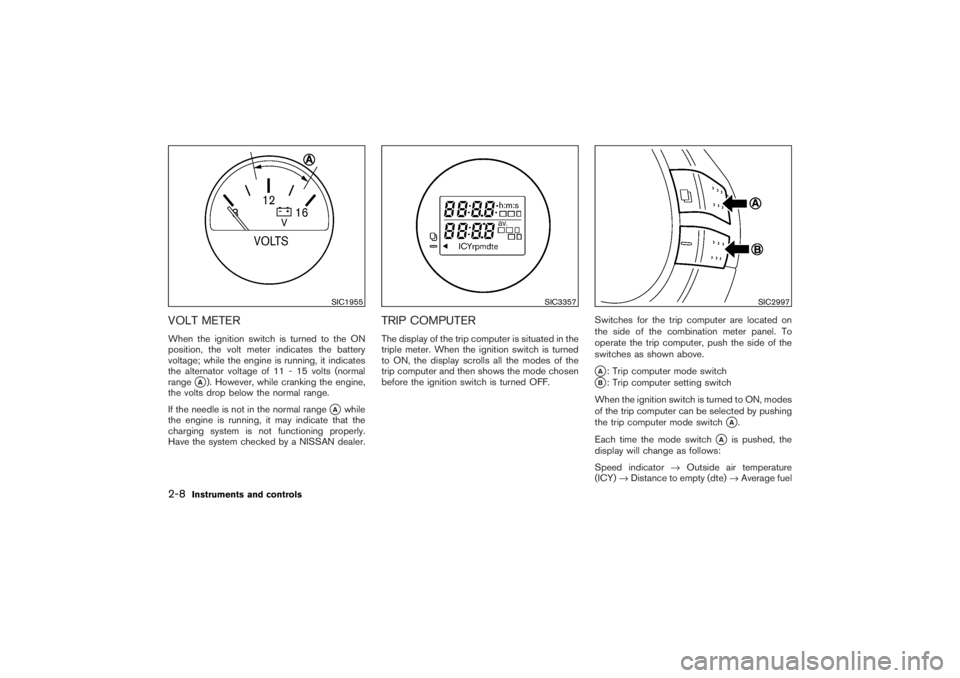Page 71 of 311

VOLT METERWhen the ignition switch is turned to the ON
position, the volt meter indicates the battery
voltage; while the engine is running, it indicates
the alternator voltage of 11 - 15 volts (normal
range
�A). However, while cranking the engine,
the volts drop below the normal range.
If the needle is not in the normal range
�A
while
the engine is running, it may indicate that the
charging system is not functioning properly.
Have the system checked by a NISSAN dealer.
TRIP COMPUTERThe display of the trip computer is situated in the
triple meter. When the ignition switch is turned
to ON, the display scrolls all the modes of the
trip computer and then shows the mode chosen
before the ignition switch is turned OFF.Switches for the trip computer are located on
the side of the combination meter panel. To
operate the trip computer, push the side of the
switches as shown above.
�A: Trip computer mode switch
�B: Trip computer setting switch
When the ignition switch is turned to ON, modes
of the trip computer can be selected by pushing
the trip computer mode switch
�A.
Each time the mode switch
�A
is pushed, the
display will change as follows:
Speed indicator→Outside air temperature
(ICY)→Distance to empty (dte)→Average fuel
SIC1955
SIC3357
SIC2997
2-8
Instruments and controls
�
07.2.9/Z33-D/V5.0
�
Page 75 of 311

Automatic transmission check
warning light (A/T models)
When the ignition switch is turned to the ON
position, the automatic transmission check
warning light comes on and then turns off. This
indicates that the automatic transmission system
is operational.
If the light comes on while the engine is running
or while driving, it may indicate that the auto-
matic transmission system is not functioning
properly. Have a NISSAN dealer check and
repair the transmission.
or
Brake warning light
This light functions for both the parking brake
and the foot brake systems.
Parking brake indicator:
When the ignition switch is in the ON position,
the light comes on when the parking brake is
applied.
Low brake fluid warning light:
The light warns of a low brake fluid level. If the
light comes on while the engine is running with
the parking brake not applied, stop the vehicle
and perform the following:
1. Check the brake fluid level. Add brake fluid as
necessary. See “Brake and clutch fluid” in the
“8. Maintenance and do-it-yourself” section.
WARNING
�Your brake system may not be work-
ing properly if the warning light is on.
Driving could be dangerous. If you
judge it to be safe, drive carefully to
the nearest service station for re-
pairs. Otherwise, have your vehicle
towed because driving it could be
dangerous.
�Pressing the brake pedal with the
engine stopped and/or a low brake
fluid level may increase your stop-
ping distance and braking will re-
quire greater pedal effort as well as
pedal travel.
�If the brake fluid level is below the
MINIMUM or MIN mark on the brake
fluid reservoir, do not drive until the
brake system has been checked at a
NISSAN dealer.
2. If the brake fluid level is correct, have the
warning system checked by a NISSAN
dealer.Anti-lock Braking System (ABS) warning
indicator:
When the parking brake is released and the
brake fluid level is sufficient, if both the brake
warning light and the ABS warning light illumi-
nate, it may indicate the ABS is not functioning
properly. Have the brake system checked by a
NISSAN dealer. See “Anti-lock Braking System
(ABS) warning light” earlier in this section.
Charge warning light
If the light comes on while the engine is running,
it may indicate that the charging system is not
functioning properly. Turn the engine off and
check the alternator belt. If the belt is loose,
broken, missing or if the light remains on, see a
NISSAN dealer immediately.
CAUTION
Do not continue driving if the belt is
loose, broken or missing.
Door open warning light
This light comes on when any of the doors
and/or rear hatch are not closed securely while
the ignition switch is in the ON position.
2-12
Instruments and controls
�
07.2.9/Z33-D/V5.0
�
Page 251 of 311

Check the fluid level in each cell. It should be
between the UPPER LEVEL
�1
and LOWER
LEVEL
�2lines.
If it is necessary to add fluid, add only distilled
water to bring the level to the indicator in each
filler opening.Do not overfill.
Vehicles operated in high temperatures or under
severe conditions require frequent checks of the
battery fluid level.
1. Remove the cell plugs
�A.
2. Add distilled water up to the UPPER LEVEL
line
�1.
3. Tighten cell plugs.
JUMP STARTINGIf jump starting is necessary, see “Jump starting”
in the “6. In case of emergency” section. If the
engine does not start by jump starting, the
battery may have to be replaced. Contact a
NISSAN dealer.1. Power steering fluid pump
2. Alternator
3. Crankshaft pulley
4. Air conditioner compressor
5. Drive belt auto-tensioner
WARNING
Be sure the ignition key is in the OFF or
LOCK position before servicing drive
belts. The engine could rotate
DI0137MA
SDI1480
SDI2061
DRIVE BELTS
8-16
Maintenance and do-it-yourself
�
07.2.9/Z33-D/V5.0
�